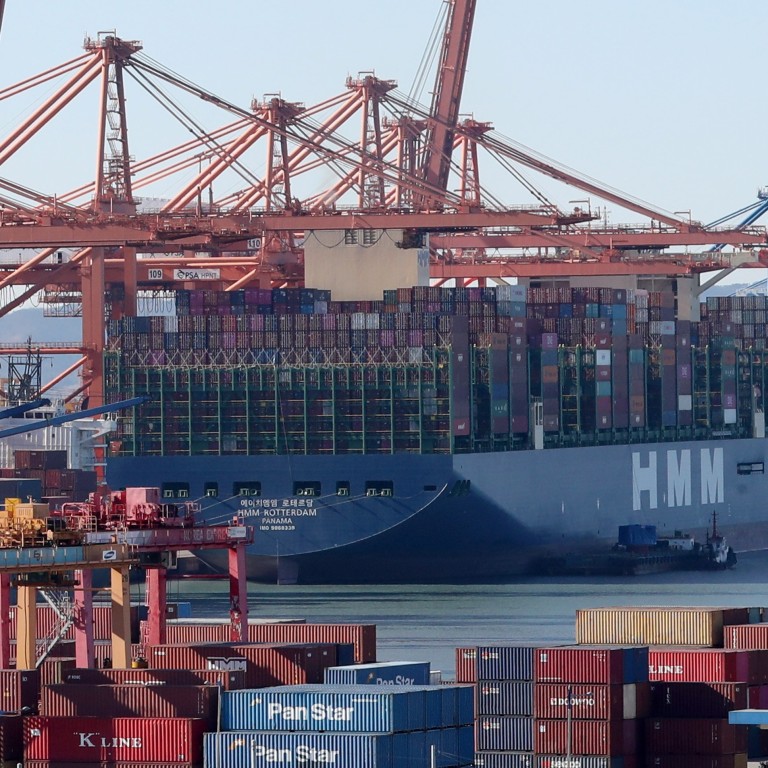
South Korea’s China exports plunge 15.7 per cent, underscoring drop in semiconductor demand
- Drop in critical computer chip shipments – accounting for the bulk of South Korea’s exports – was reflected in the continued contracting of factory activity last month
- Although South Korea’s exports to China have decreased for five straight months, those to the US and EU increased in October
South Korea’s export growth rate turned negative in October for the first time in two years, driven by a fall in crucial semiconductor shipments as well as weakened trade with China, leading to South Korea’s overall trade deficit persisting for a seventh consecutive month.
Exports decreased by a worse-than-expected 5.7 per cent to US$52.48 billion compared with the same month in 2021, the South Korean Ministry of Trade, Industry and Energy said on Tuesday. This also represented the biggest percentage fall since August 2020, having declined for the first time since October 2020.
Export values of petroleum products and automobile parts increased as well, by 7.6 and 3.2 per cent, respectively. Both are among the country’s 15 major export products.
China’s weak growth has had a negative impact on inter-regional exports … China’s slowdown and the downcycle for semiconductors are expected to continue for a while
“[The drop in semiconductor exports is] mainly due to sluggish global demand and unfavourable price effects,” said Kang Min-joo, a senior economist at ING who focuses on the economies of South Korea and Japan.
“China’s weak growth has had a negative impact on inter-regional exports, while consumer demand in the developed markets has not yet fallen substantially.
“External demand conditions for semiconductors are not expected to improve in the short term, as China’s slowdown and the downcycle for semiconductors are expected to continue for a while.”
South Korea’s exports to China, Japan and the Association of Southeast Asian Nations (Asean) all decreased in October.
South Korean weapon exports may top China’s as Seoul inks more defence deals
The export fall was reflected in South Korea’s still-contracting factory activity, according to a private-sector survey released on Tuesday.
The S&P Global purchasing managers’ index did rise for the first time in six months – to a seasonally adjusted 48.2 in October from 47.3 in September – but it remained for a fourth straight month below the 50-mark that separates expansion from contraction.
It also showed that orders for exports in October shrank for an eighth straight month.
Official figures show that South Korea’s exports to China posted the biggest drop of 15.7 per cent, while exports to Japan and the Asean bloc decreased by 13.1 per cent and 5.8 per cent, respectively.
South Korea’s exports to China have now decreased for five consecutive months. Meanwhile, exports to the United States and European Union respectively increased by 6.6 per cent and 10.3 per cent in October, year on year.
South Korea’s overall export growth rate has also been steadily decreasing since sharply dropping from 21.4 per cent in May to 5.3 per cent in June. That June figure also marked the first time in 16 months that the country’s export growth rate fell into the single digits.
Since then, South Korea’s export growth rate has stayed low and kept decreasing after a slight recovery in July to 9 per cent, followed by 6.6 per cent in August, 2.8 per cent in September and finally minus 5.7 per cent last month.
The Korean government, though, said that the country’s accumulated trade value this year is 10.3 per cent higher than the same period last year, while attributing October’s negative growth to the global economic slowdown resulting from the protracted Ukrainian war and the monetary tightening policies of major countries.
“This year’s annual export amount is expected to break the previous high of US$644.4 billion in 2021,” the government statement added.
Is South Korea’s economy heading towards a crisis?
South Korea’s overall imports grew by 9.9 per cent in October, resulting in a trade deficit of US$6.7 billion, which has been attributed to rising energy prices.
“The fact that major energy prices – such as for oil, gas, and coal – remained high compared with the previous year, and that energy imports increased by US$4.6 billion from the previous year, significantly affected the trade deficit,” said Lee Chang-yang, South Korea’s minister of trade, industry and energy.
Bolstering South Korean exports will not be easy in the short term, with global economic risks persisting due to inflation and the Ukraine war, Lee added.
“The government is very seriously aware of the recent situation – with the continued trade deficit and the decline in exports in October – and will fully support the enhancement of export vitality by mobilising all available means,” he said.

